(完整版)高考必考英语语法大全
高考英语十个必考的语法

高考英语十个必考的语法高考英语十个必考的语法1.固定搭配Without solutions _____the gap between the rich and the poor, there can be no “harmonious society”.A. ofB. forC. toD. on正确答案C高考考点介词的用法详细解析接下来我们就来看一下跟介词to搭配的名词,因为这道题目考的刚好是名词后面搭配什么介词。
accesshave access to“有通道/有使用/有见到(某人/某物的机会或权利)”answeranswer to“对…的回答”approachapproach to sth. / approach to doing sth.“做某件事情的方法”attentionpay attention to我们都学过了attitudeattitude to sth.“对待…的态度”contributionm ake contributions to sth.“对…做出贡献”damagedo damage to sth.“对…造成损坏、破坏”devotiondevotion to sth.“对…的奉献”entranceentrance to“某某地方的一个入口”introductionintroduction to sth.“对…的介绍、入门”keythe key to sth.“钥匙、答案”limitthe limit to sth.“对什么东西的一个限度/限制”objectionthe objection to“对…的反对”reactionreaction to sth.“对…东西的反应”responseresponse to sb./sth. “对…人(或物)的回答/回复”solutionsolution to sth.“对某件事情的解决方法”举例:—Students must have access to good resources.学生必须要有能够获得好的资源的权利。
(完整word版)高考英语语法知识清单
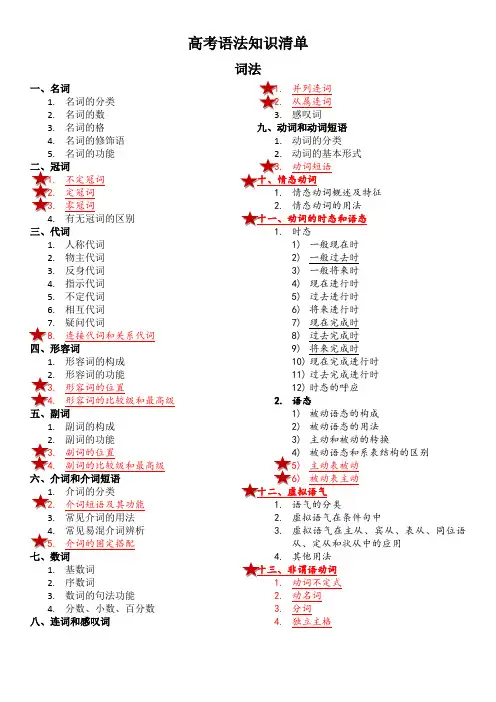
高考语法知识清单词法一、名词1. 名词的分类2. 名词的数3. 名词的格4. 名词的修饰语5. 名词的功能不定冠词定冠词零冠词有无冠词的区别三、代词1. 人称代词2.物主代词 3.反身代词 4. 指示代词5. 不定代词6.相互代词疑问代词连接代词和关系代词1. 形容词的构成 形容词的功能 形容词的位置形容词的比较级和最高级1. 副词的构成 副词的功能 副词的位置副词的比较级和最高级 六、介词和介词短语介词的分类介词短语及其功能 3. 常见介词的用法 常见易混介词辨析 介词的固定搭配 七、数词1. 基数词2. 序数词3. 数词的句法功能4. 分数、小数、百分数 八、连词和感叹词 并列连词从属连词 感叹词九、动词和动词短语1. 动词的分类2. 情态动词的用法 1) 一般现在时 2) 一般过去时 3) 一般将来时 4) 现在进行时 5) 过去进行时 6) 将来进行时 7) 现在完成时 8) 过去完成时 9) 将来完成时10) 现在完成进行时 11) 过去完成进行时 12) 时态的呼应 2. 语态1) 被动语态的构成 2) 被动语态的用法 3) 主动和被动的转换2. 虚拟语气在条件句中3. 虚拟语气在主从、宾从、表从、同位语从、定从和状从中的应用 4. 其他用法 动词不定式 2. 动名词 3. 分词 4. 独立主格句法一、句子成分和句子种类1.句子成分2.句子种类2.主谓一致的几种情况2.主语从句3.宾语从句4.表语从句5.同位语从句6.直接引语和间接引语2.定语从句的分类3.关系代词4.关系副词5.介词+关系代词6.注意事项7.定语从句和同位语从句的区别8.定语从句和短语的转化2.地点状语从句3.条件状语从句4.目的状语从句5.原因状语从句6.结果状语从句7.让步状语从句8.比较状语从句9.方式状语从句10.状语从句的省略六、特殊句式1.there be结构倒装强调省略5.插入语七、情景交际1.社会交往2.态度3.情感。
高考英语语法归纳大全
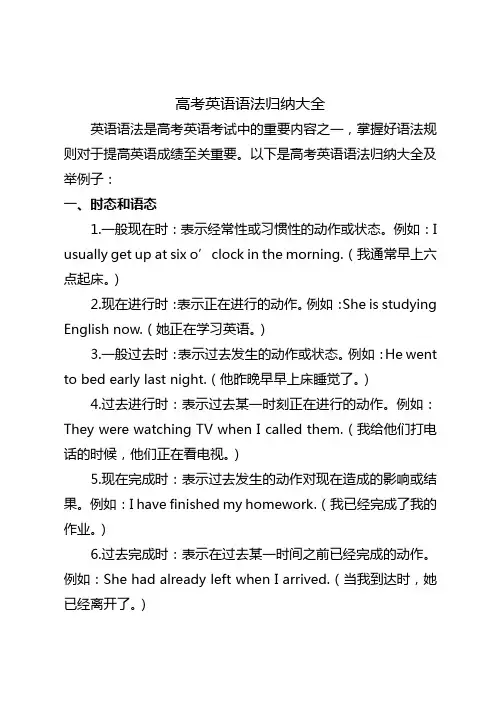
高考英语语法归纳大全英语语法是高考英语考试中的重要内容之一,掌握好语法规则对于提高英语成绩至关重要。
以下是高考英语语法归纳大全及举例子:一、时态和语态1.一般现在时:表示经常性或习惯性的动作或状态。
例如:I usually get up at six o’clock in the morning.(我通常早上六点起床。
)2.现在进行时:表示正在进行的动作。
例如:She is studying English now.(她正在学习英语。
)3.一般过去时:表示过去发生的动作或状态。
例如:He went to bed early last night.(他昨晚早早上床睡觉了。
)4.过去进行时:表示过去某一时刻正在进行的动作。
例如:They were watching TV when I called them.(我给他们打电话的时候,他们正在看电视。
)5.现在完成时:表示过去发生的动作对现在造成的影响或结果。
例如:I have finished my homework.(我已经完成了我的作业。
)6.过去完成时:表示在过去某一时间之前已经完成的动作。
例如:She had already left when I arrived.(当我到达时,她已经离开了。
)7.将来时:表示将要发生的动作或状态。
例如:We will go to the park tomorrow.(我们明天会去公园。
)8.被动语态:表示动作的承受者是主语。
例如:The book was written by him.(这本书是他写的。
)二、从句1.名词性从句:在句子中作主语、宾语、表语等成分的从句。
例如:What he said is true.(他说的是真的。
)2.定语从句:修饰先行词的从句。
例如:The man who is standing there is my father.(站在那里的人是我的父亲。
)3.状语从句:在句子中作时间、地点、原因、条件等状语的从句。
高考英语语法整理(全)
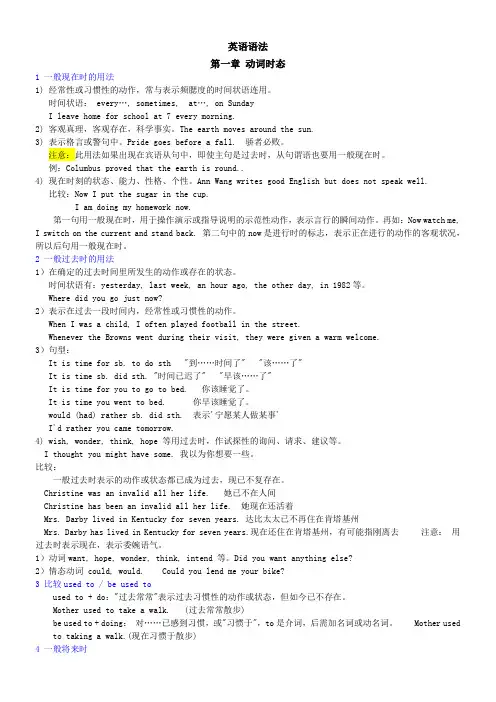
英语语法第一章动词时态1 一般现在时的用法1) 经常性或习惯性的动作,常与表示频腮度的时间状语连用。
时间状语: every…, sometimes, at…, on SundayI leave home for school at 7 every morning.2) 客观真理,客观存在,科学事实。
The earth moves around the sun.3) 表示格言或警句中。
Pride goes before a fall. 骄者必败。
注意:此用法如果出现在宾语从句中,即使主句是过去时,从句谓语也要用一般现在时。
例:Columbus proved that the earth is round..4) 现在时刻的状态、能力、性格、个性。
Ann Wang writes good English but does not speak well.比较:Now I put the sugar in the cup.I am doing my homework now.第一句用一般现在时,用于操作演示或指导说明的示范性动作,表示言行的瞬间动作。
再如:Now watch me, I switch on the current and stand back. 第二句中的now是进行时的标志,表示正在进行的动作的客观状况,所以后句用一般现在时。
2 一般过去时的用法1)在确定的过去时间里所发生的动作或存在的状态。
时间状语有:yesterday, last week, an hour ago, the other day, in 1982等。
Where did you go just now?2)表示在过去一段时间内,经常性或习惯性的动作。
When I was a child, I often played football in the street.Whenever the Browns went during their visit, they were given a warm welcome.3)句型:It is time for sb. to do sth "到……时间了" "该……了"It is time sb. did sth. "时间已迟了" "早该……了"It is time for you to go to bed. 你该睡觉了。
高考常考英语语法知识点总结归纳
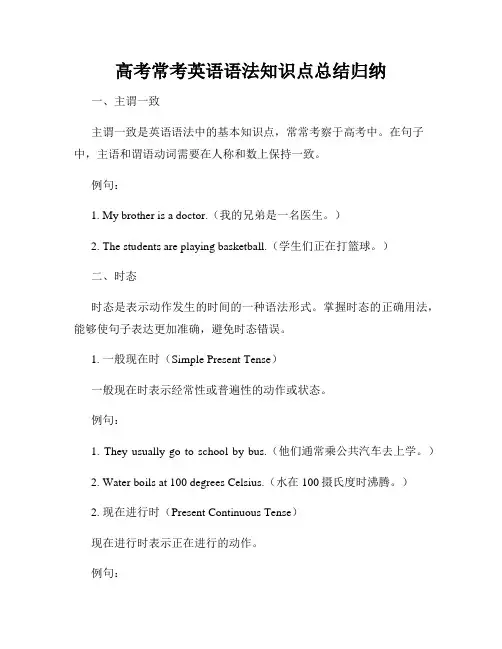
高考常考英语语法知识点总结归纳一、主谓一致主谓一致是英语语法中的基本知识点,常常考察于高考中。
在句子中,主语和谓语动词需要在人称和数上保持一致。
例句:1. My brother is a doctor.(我的兄弟是一名医生。
)2. The students are playing basketball.(学生们正在打篮球。
)二、时态时态是表示动作发生的时间的一种语法形式。
掌握时态的正确用法,能够使句子表达更加准确,避免时态错误。
1. 一般现在时(Simple Present Tense)一般现在时表示经常性或普遍性的动作或状态。
例句:1. They usually go to school by bus.(他们通常乘公共汽车去上学。
)2. Water boils at 100 degrees Celsius.(水在100摄氏度时沸腾。
)2. 现在进行时(Present Continuous Tense)现在进行时表示正在进行的动作。
例句:1. I am studying for the exam.(我正在为考试学习。
)2. She is watching TV right now.(她正在看电视。
)3. 过去时态(Past Tense)过去时态表示过去某个时间发生的动作或存在的状态。
例句:1. We visited the Great Wall last week.(我们上周参观了长城。
)2. He worked in that company for three years.(他在那家公司工作了三年。
)三、从句的引导词从句是一个可以独立存在的句子,它通常包含一个主语和谓语。
从句根据其功能可以分为名词性从句、形容词性从句和副词性从句。
1. 名词性从句名词性从句在句子中充当名词的角色,可以作主语、宾语、表语、同位语等。
例句:1. What he said is true.(他所说的是真的。
)2. I don't know where he is.(我不知道他在哪里。
高考英语必考语法知识点
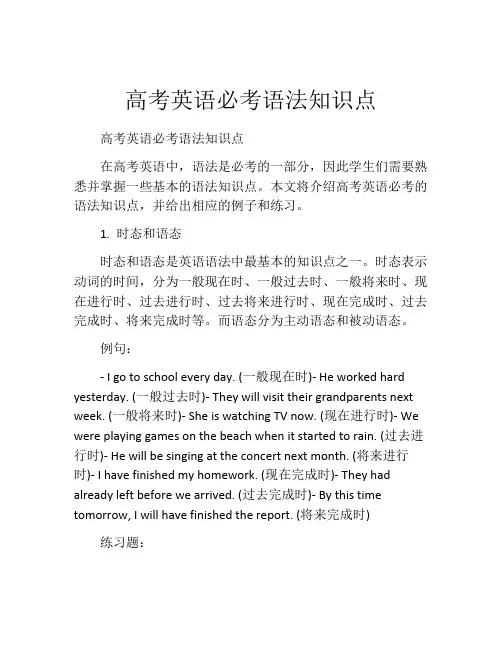
高考英语必考语法知识点高考英语必考语法知识点在高考英语中,语法是必考的一部分,因此学生们需要熟悉并掌握一些基本的语法知识点。
本文将介绍高考英语必考的语法知识点,并给出相应的例子和练习。
1. 时态和语态时态和语态是英语语法中最基本的知识点之一。
时态表示动词的时间,分为一般现在时、一般过去时、一般将来时、现在进行时、过去进行时、过去将来进行时、现在完成时、过去完成时、将来完成时等。
而语态分为主动语态和被动语态。
例句:- I go to school every day. (一般现在时)- He worked hard yesterday. (一般过去时)- They will visit their grandparents next week. (一般将来时)- She is watching TV now. (现在进行时)- We were playing games on the beach when it started to rain. (过去进行时)- He will be singing at the concert next month. (将来进行时)- I have finished my homework. (现在完成时)- They had already left before we arrived. (过去完成时)- By this time tomorrow, I will have finished the report. (将来完成时)练习题:- Mary (to listen) to music now.- We (to study) English yesterday.- My mom (to make) breakfast for me tomorrow.- The company (to hire) a new employee next month.- I (to finish) the project by 5 pm tomorrow.答案:- is listening- studied- will make- will hire- will finish2. 疑问句和否定句疑问句和否定句是日常生活中最常用的句子类型之一。
高考英语高频语法
高考英语语法总结大全1.形容词作状语表示伴随或结果,并不表达动作的方式。
After the long journey,the three of them went back home,hungry and tired.经过长时间旅行后,他们三个回到家,又饿又累。
2.有些副词还可以作连词,作副词时常放在句末。
如:though,(ever)since,in case等He is old. He works hard,though.=Though he is old,he works hard.虽然他年事已高,但他工作还是很努力。
3.有些副词置于句首可修饰全句,作评注性状语。
如:obviously,naturally,surprisingly等Fortunately,he was not drowned and was saved by the PLA.幸运的是,他没被淹死,被解放军给救了。
Happily for her,her stepmother was kind to her.高兴的是,她的继母对她很好。
4.can not/never 与enough 或too连用表示:无论怎样都不过分;越……越好。
—I was riding alone in the street and all of a sudden,a car cut in and knocked me down.——我正在大街上独自一人骑自行车,突然一辆小汽车强行超车把我撞倒了。
—You can never be too careful in the street.——在大街上你越小心越好。
考向二形容词、副词的比较级和最高级1."as+形容词+(a/an)+名词+as"表示同级比较,注意中间的形容词和名词并列时各自所在的位置。
It is generally believed that teaching is as much an art as it is a science.人们普遍认为,教学是一门科学,同时也是一门艺术。
(完整版)高中英语语法大全
高中英语语法系统全解第1章动词时态第2章被动语态第3章虚拟语气第4章情态动词第5章动词不定式第6章动词的ing形式第7章过去分词第8章独立主格结构第9章名词性从句第10章定语从句第11章状语从句(一)第11章状语从句(二)第12章直接引语和间接引语第13章倒装第14章强调第15章省略第16章主谓一致动词时态--一般时第一章动词时态(一)在英语中,不同时间发生的动作或存在的状态,要用不同的动词形式来表示,这就叫做动词的时态。
一、一般时一般时包括一般现在时、一般过去时、一般将来时和一般过去将来时。
A.一般现在时1.一般现在时的构成一般现在时主要用动词原形来表示。
主语是第三人称单数时,动词后面要加-s 或-es。
They want good jobs.他们想要好的工作。
The coat matches the dress.外衣和裙子很相配。
This work does not satisfy me.这项工作我不满意。
Do you understand?你懂了吗?2.一般现在时的用法①一般现在时的基本用法a.表示现在习惯性的动作或存在状态He always takes a walk after supper.晚饭后他总是散散步。
Everyone is in high spirits now.现在大家都情绪高涨。
b.表示客观事实或普遍真理The sun rises in the east and sets in the west.太阳从东方升起在西方落下。
Sound travels faster through water than it does through air.声音在水中的传播速度要比在空气中快。
Time and tide wait for no man.时间不等人。
c.表示主语的特征、能力和状态This cloth feels soft.这布摸上去很软。
I love classical music.我喜欢古典音乐。
高考英语必考知识点归纳
高考英语必考知识点归纳如下一、语法部分1. 动词的时态和语态-一般现在时、一般过去时、一般将来时、现在进行时、过去进行时、将来进行时、现在完成时、过去完成时、将来完成时等各种时态的构成和用法。
-主动语态和被动语态的转换及不同时态下的被动语态形式。
2. 非谓语动词-动词不定式、动名词、分词(现在分词和过去分词)的用法区别。
-非谓语动词在句中作主语、宾语、表语、定语、状语等不同成分时的用法。
3. 名词性从句-主语从句、宾语从句、表语从句、同位语从句的引导词及用法。
4. 定语从句-关系代词(that、which、who、whom、whose)和关系副词(when、where、why)的用法。
-限制性定语从句和非限制性定语从句的区别。
5. 状语从句-时间状语从句(when、while、as、since、until 等)、条件状语从句(if、unless 等)、原因状语从句(because、since、as 等)、结果状语从句(so...that...、such...that...等)、让步状语从句(although、though、even though 等)等各类状语从句的引导词及用法。
6. 虚拟语气-对现在、过去、将来的虚拟情况的表达形式。
-虚拟语气在条件句、宾语从句、主语从句等中的应用。
7. 特殊句式-强调句、倒装句、省略句的结构和用法。
二、词汇部分1. 高频词汇-掌握高考大纲要求的3500 个左右的词汇,重点记忆高频词汇的词义、用法和搭配。
-注意一词多义、熟词生义的情况。
2. 短语和固定搭配-动词短语、介词短语、形容词短语等的记忆和运用。
-常见的固定搭配,如take part in、make progress、in order to 等。
三、阅读理解部分1. 题型特点-主旨大意题、细节理解题、推理判断题、词义猜测题等不同题型的解题方法。
2. 阅读技巧-快速浏览文章,了解文章大意和结构。
-仔细阅读题干和选项,带着问题在文章中找答案。
英语高考必考知识点
英语高考必考知识点一、语法与词汇1. 时态- 一般现在时:表示习惯性动作或普遍真理。
- 一般过去时:描述过去发生的动作或状态。
- 现在进行时:表示正在进行的动作。
- 过去进行时:表示过去某一时刻正在进行的动作。
- 一般将来时:表示将来会发生的动作。
- 现在完成时:强调过去发生的动作对现在的影响或结果。
- 过去完成时:表示在过去某一动作之前已经完成的另一动作。
- 将来完成时:表示在将来某一时刻之前将已经完成的动作。
2. 语态- 被动语态:强调动作的承受者而非执行者。
- 主动改被动:将主动语态转换为被动语态。
3. 非谓语动词- 动名词:作为名词使用,可以作主语、宾语等。
- 分词(现在分词和过去分词):用作形容词或副词。
- 不定式:用作名词、形容词、副词等。
4. 情态动词- can/could, may/might, must, should/ought to等:表达可能性、许可、义务、建议等。
5. 代词- 人称代词:主格和宾格的使用。
- 物主代词:形容词性物主代词和名词性物主代词。
- 反身代词、指示代词、疑问代词等。
6. 冠词- 不定冠词(a/an)和定冠词(the)的使用。
7. 介词- 常用介词的用法,如at, in, on, for, with, by, etc.8. 连词- 并列连词:and, but, or, so等。
- 从属连词:because, since, although, if, when, etc.9. 句子结构- 简单句、复合句和复杂句的构成。
- 陈述句、疑问句、祈使句和感叹句。
10. 词汇- 常用词汇的记忆和理解。
- 同义词、反义词、短语动词等。
二、阅读理解1. 快速阅读- 快速获取文章大意和主旨。
- 通过标题、首段、尾段和段落首句快速把握文章结构。
2. 细节理解- 理解文章中的具体信息和细节。
- 通过上下文推断生词或难句的含义。
3. 推理判断- 根据文章内容进行逻辑推理。
- 1、下载文档前请自行甄别文档内容的完整性,平台不提供额外的编辑、内容补充、找答案等附加服务。
- 2、"仅部分预览"的文档,不可在线预览部分如存在完整性等问题,可反馈申请退款(可完整预览的文档不适用该条件!)。
- 3、如文档侵犯您的权益,请联系客服反馈,我们会尽快为您处理(人工客服工作时间:9:00-18:30)。
高考必考英语语法大全虚拟语气在各种从句的应用主语从句的虚拟1. It is + adj. + that sb. (should) do常见的形容词有:necessary, important, strange, naturalIt's important that he take my advice.2. It is + n. + that sb. (should) do常见的名词有: a pity, a shame, no wonder, one's wishIt's a pity that he be so silly.3. It is + done + that sb. (should) do常见的过去分词有:suggested, advised, demanded, requested, required, asked, ordered, proposed, decided, desired, insisted等。
It's requested that she go home as soon as possible.宾语从句的虚拟1. 表命令,表建议,表要求的动词,后接宾语从句虚拟。
虚拟的构成为(should) do。
I advise that he stay at home.2. wish后接从句,虚拟的构成是往过去推一个时态。
I wish I had watched the football match last night.注意以下几组词或短语用于虚拟语气中。
1. as if, as thoughHe speaks English as if he were a native speaker.2. otherwise, but, even thoughHe was ill. Otherwise he would have been there.3. with, without, but forWithout your help, I would have died two years ago.But for your help, I would have died two years ago.4. would rather I'd rather you told me yourself.5. It's time thatIt's time that you went to bed.It's time that you should go to bed.表语从句中的虚拟在表语从句中,表示间接的命令,要求、请求、建议、决定等,主句中的主语通常是suggestion, proposal, request, orders, idea等。
从句谓语形式是"(should)+动词原形"。
如:His suggestion is that we (should) leave at once.名词从句部分:1. that不可省略的情况2. that引导同位语从句和that引导定语从句的区别:同位语从句中的that是连词,不做成分,只连接主从句,不能省略;定语从句中的that要代替先行词在从句中做主语、宾语或者表语,并且做宾语时可以省略。
从语义上看,同位语从句是对前面名词的解释、说明或内容;而定语从句时对前面名词的限定。
ol library provide more books on We should consider the students’request that the schopopular science. (that引导同位语从句)The only hope that he expressed was that they would do what they could to help the people in disaster areas. (that引导定语从句)3. 要根据句子结构尤其是谓语动词判断从句的类型:What is known to us all is that the 2008 Olympic Games took place in Beijing.本句含有一个主语从句和一个表语从句,主句的动词为is。
It is known to us all that the 2008 Olympic Games took place in Beijing.本句含有一个主语从句,主句的动词为is known to。
As is known to us all, the 2008 Olympic Games took place in Beijing.本句含有一个定语从句,主句的动词为took place,as引导非限制性定语从句。
4. 名词性从句的语序和语态。
名词性从句均应用陈述语序,不能用疑问语序,其时态应该和主句时态保持一致。
5. 名词性从句中连词的省略。
介词后的连词以及引导主语从句和同位语从句的连词不可省略。
that引导名词从句(除了引导第一个宾语从句可省略外)都不可省略,但是引导定语从句并在从句中做宾语时可以省略。
that不能省略的情况:1)介词后面的that不能省略:Peter is a good student except that he is sometimes careless.2)当that引导的宾语从句位于句首时:That he ever did such a thing I don’t believe.3)主句谓语动词和that从句之间有插入语,that不省略:She said that, if she failed, she would try again.4)当宾语从句有其他从属连词时,that不省略:He told me that if it was necessary they would work extra time.6.名词性从句中it的使用:为了保持句子平衡,多数情况下,it作形式主语或形式宾语,将真正的主语或宾语从句后置。
定语从句关系代词有who, whom, whose, which, that, as,和关系副词when, where, why。
(1)that指物时一般可与which互换,但在下列情况下,要用that而不用which。
a. 先行词有all, everything等不定代词时,如,Everything (that) he did is wrong.b. 先行词被all, every, no, some, any, little, much等修饰时,如,I'll read all the books (that) you lend me.c. 先行词被序数词或形容词最高级修饰时,This is the first letter (that) the boy has written.d. 先行词被the only, the very, the same, the last修饰时,如He is the very man (that) I'm looking for.e. 只用which的情况在介词后或在非限定性定语从句中This is the book about which we have talked a lot.The book, which he gave me yesterday, is very interesting.f. where和when作关系副词This is the room where I worked.This is the room which I stayed in.I remembered the day when we lived there.I remembered the day that I spent there.g. as和whichas 可以放于句首,而which 不可以As you know, he is good at English.three of them 和three of whichI have a lot of books, three of which are in Russian.I have a lot of books and three of them are in Russian.介词+关系代词”的情况:(2. )“在固定短语中介词不能提前;判断介词的口诀:瞻前顾后看意义瞻前——看先行词;顾后——找从句动词;看意义——看全句表达含义(3. )先行词在从句中充当地点状语时,关系词用where 或者介词加which;先行词在从句中充当时间状语时,关系词用when或者介词加which;先行词在从句中充当原因状语时,关系词用why或者for which。
(4. )注意as和which在非限制性定语从句中代表主句所表达的内容的区别:位置不同:as从句放在主句前或后均可;而which从句只能放在主句后作用不同:as从句动词常常是see \know等,因而相当于插入语;which从句则在陈述一件事实。
状语从句部分1.while 是高考中的高频词,它既可引导时间状语从句,又可引导并列句,还可引导让步状语从句,表示“尽管”。
2. no matter wh- 与wh-ever 的联系及区别:no matter wh- 只引导让步状语从句,此时与wh-ever通用。
wh-ever又可引导名词性从句,No matter wh-不能。
No matter when / Whenever he comes back, he should be invited to the party.3. 在条件,时间和让步从句中,用一般现在时表示一般将来时,用现在完成时表将来完成时,用一般过去时表过去将来时。
在since 引导的时间状语从句中,动词一般都用一般过去时,而主句常用现在完成时。
4. 状语从句的倒装一般有下面几种情况:①否定词开头;②so 加adj. 开头;③as /though引导的让步状语从句。
5. 连词before小结:才)We had sailed four days before we saw land. (……We hadn’t run a mile before he felt tired. (不到……就)Please write it down before you forget it. (趁……)Before I could get in a word, he had measured me. (还没来得及)要过多久才……It will be/was…before…6. because, since, as 引导原因从句的区别:because表达直接原因,语气最强,回答why;since通常放句首,译为“既然”;as引导不谈自明的原因,语气最弱;7. as可以引导多种从句,要注意其中的区别。
